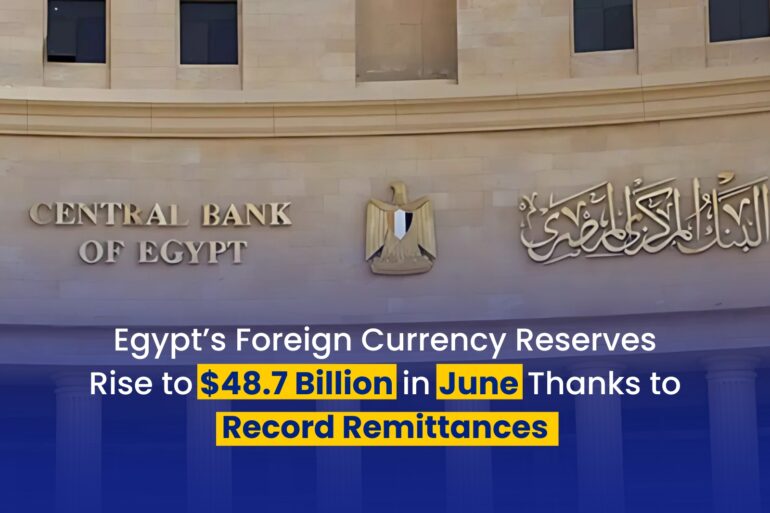Egypt’s economy has reached a significant milestone in June 2025, with the Central Bank of Egypt (CBE) announcing that the country’s net international reserves surged to an all-time high of $48.7 billion, up from $48.526 billion in May. This increase of approximately $174 million marks a pivotal moment in Egypt’s ongoing economic recovery, driven largely by a remarkable 77% year-on-year surge in remittances from Egyptians working abroad, which reached $29 billion in the first ten months of the fiscal year 2024–25. This blog explores the factors behind this record-breaking achievement, its implications for Egypt’s economic stability, and the broader context of the nation’s financial reforms.
The Role of Remittances in Boosting Reserves
Remittances from Egyptians abroad have emerged as a cornerstone of the country’s foreign currency reserves, serving as a vital lifeline for an economy navigating global and regional challenges. In April 2025 alone, remittances soared by 39% compared to the previous year, reaching $3 billion, as expatriates increasingly utilized formal banking channels following the currency liberalization measures implemented in March 2024. The CBE reported that remittances for the fiscal year 2024–25 hit $32.6 billion from March 2024 to February 2025, a 72.4% increase from the previous period. This unprecedented inflow reflects growing confidence in Egypt’s financial system, spurred by economic reforms that unified the official and parallel market exchange rates and stabilized the Egyptian pound at approximately 40 EGP per USD.
The devaluation of the Egyptian pound in March 2024, coupled with a significant 6% interest rate hike, incentivized expatriates to send more funds through official channels, as the weaker pound increased the local currency value of each dollar remitted. This shift has curtailed the use of informal remittance channels, such as the black market, which had previously drained potential reserves. The CBE’s strategic measures, including tighter regulations and incentives for formal banking, have been instrumental in channeling these funds into the national economy, bolstering liquidity and supporting macroeconomic stability.
Broader Economic Reforms and External Support
The surge in foreign currency reserves is not solely attributable to remittances. Egypt’s economic recovery has been underpinned by a series of strategic reforms and substantial external financing. In March 2024, a landmark $35 billion investment from the UAE’s ADQ for the development of Ras El Hekma significantly boosted reserves, pushing them from $35.3 billion to $40.4 billion in a single month. Additionally, Egypt secured an $8 billion financing program from the International Monetary Fund (IMF), $8 billion from the European Union, and $6 billion from the World Bank, alongside $1.2 billion from the IMF’s sustainability fund. These inflows, totaling over $58 billion, have provided critical support for Egypt’s external financing needs and debt obligations.
The CBE’s diversified reserve portfolio, comprising major global currencies such as the US dollar, euro, British pound, Japanese yen, and Chinese yuan, as well as gold reserves valued at $13.586 billion in June 2025, ensures flexibility in managing economic uncertainties. The bank’s strategic allocation of these assets, based on exchange rate stability and global market trends, has further strengthened Egypt’s financial resilience. Moreover, the rebound in tourism revenues, projected to reach $15.3 billion in 2025, and a 33% increase in non-oil exports in the first nine months of the fiscal year have complemented remittance inflows, further fortifying the reserve base.
Implications for Debt Sustainability and Currency Stability
The record-high reserves have profound implications for Egypt’s economic outlook. With external debt standing at $160.6 billion by March 2024, down 4.4% from the previous quarter, the increased reserves enhance Egypt’s ability to meet debt obligations and reduce rollover risks. The government aims to lower public debt to 85% of GDP by June 2025, from 96% in 2023, a target made more achievable by the strengthened reserve position. Additionally, the stabilization of the Egyptian pound has attracted a 17% rise in foreign direct investment in early 2025, signaling growing investor confidence in Egypt’s economic reforms.
The banking sector, including institutions like the Commercial International Bank (CIB) and the National Bank of Egypt (NBE), is poised to benefit from remittance-driven liquidity and a rebound in consumer lending. The tourism sector, supported by infrastructure investments and marketing campaigns, is expected to see double-digit revenue growth, further contributing to foreign currency inflows. However, challenges such as geopolitical tensions in the region, which could disrupt Suez Canal revenues, and persistent inflation pressures, despite a decline to 28.15% in May 2025, remain risks that require careful monitoring.
A Beacon of Economic Recovery
Egypt’s foreign currency reserves reaching $48.7 billion in June 2025 is a testament to the effectiveness of its economic reforms and the critical role of remittances in driving financial stability. The surge in remittances, fueled by currency liberalization and increased expatriate confidence, has not only bolstered reserves but also supported household incomes and economic activity across the country. Coupled with significant external investments and a rebound in tourism and exports, Egypt is carving a path toward sustainable growth.
As the nation continues to navigate a complex global economic landscape, the CBE’s prudent management of reserves and ongoing support from international partners like the IMF and the EU provide a solid foundation for further progress. While challenges such as inflation and geopolitical risks persist, the record-high reserves signal a brighter future for Egypt’s economy, offering a compelling opportunity for investors in sectors like tourism, banking, and infrastructure. By maintaining its reform momentum, Egypt is well-positioned to achieve its ambitious goal of accumulating $300 billion in reserves over the next six years, cementing its role as a beacon of stability in the region.

